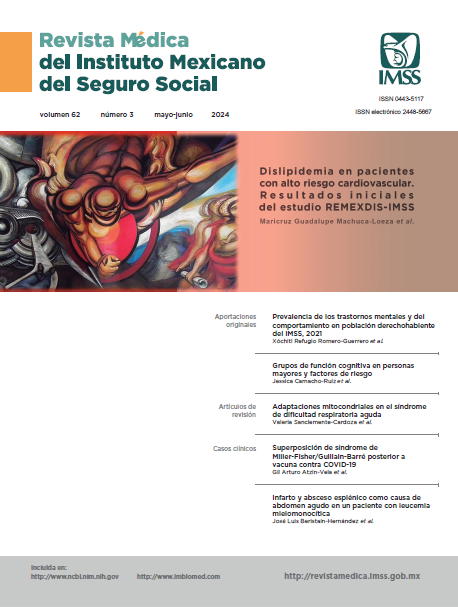Hemodialysis nutritional status and Malnutrition Inflammation Score
Main Article Content
Keywords
Renal Dialysis, Renal Insufficiency, Chronic, Nephrology, Nutritional Status
Abstract
Background: Patients with chronic kidney disease (CKD) have risk of multiple nutritional and metabolic alterations, including loss of protein and energy, obesity, nutritional deficiency, and complications derived from uremia that manifest with changes in taste and lack of appetite. However, the nutritional status of patients on hemodialysis (HD) is unknown.
Objective: To determine the nutritional status of patients with CKD with renal replacement therapy receiving HD in a tertiary care center.
Material and methods: Observational, ambispective, longitudinal study. The population included patients receiving HD in a third-level hospital. The Malnutrition and Inflammation Score (MIS) was administered to patients who agreed to participate. Together with the identification card, data on name, age, sex, body mass index (BMI), leukocytes, albumin, transferrin level, and HD time were collected.
Results: 52 patients were included. Mean age was of 46.51 years (15.54); 34 patients (65.4%) were male and 18 female (34.6%); 1 (1.9%) presented normal MIS, 32 (61.5%) mild MIS, 18 (34.6%) moderate MIS, and 1 (1.9%) severe MIS.
Conclusions: Nutritional status is poor in patients with CKD receiving HD, which is why it must include a monitoring protocol that translates into a benefit in the face of patient morbidity and mortality.
References
García-Maset R, Bover J, Segura de la Morena J, et al. Documento de información y consenso para la detección y manejo de la enfermedad renal crónica. Nefrologia. 2022;42(3):233-64. doi: 10.1016/j.nefro.2021.07.010.
Kidney Disease: Improving Global Outcomes (KDIGO) Diabetes Work Group. KDIGO 2020 Clinical Practice Guideline for Diabetes Management in Chronic Kidney Disease. Kidney Int. 2020;98(4S):S1-S115. doi: 10.1016/j.kint.2020.06.019.
Torres-Toledano M, Granados-García V, López-Ocaña LR. Carga de la enfermedad renal crónica en México. Rev Med Inst Mex Seguro Soc. 2017;55(Suppl 2):S118-23. Disponible en: https://revistamedica.imss.gob.mx/editorial/index.php/revista_medica/article/view/2490/2864.
Boletín Epidemiológico. Boletín Epidemiológico del Sistema Nacional de Vigilancia Epidemiológica. Dirección General de Epidemiología. México: Secretaría de Salud; Semana 53: del 27 de diciembre del 2020 al 2 de enero del 2021. Disponible en: https://www.gob.mx/cms/uploads/attachment/file/614743/sem53.pdf.
Méndez Durán A, Méndez Bueno JF, Tapia Yañez T, et al. Epidemiología de la insuficiencia renal crónica en México. Diálisis y trasplante. 2010;31(1):7-11. doi: 10.1016/S1886-2845(10)70004-7.
Lin L, Tan W, Pan X, et al. Metabolic Syndrome-Related Kidney Injury: A Review and Update. Front Endocrinol (Lausanne). 2022;13:904001. doi: 10.3389/fendo.2022.904001.
Figuer A, Alique M, Valera G, et al. New mechanisms involved in the development of cardiovascular disease in chronic kidney disease. Nefrologia (Engl Ed). 2023;43(1):63-80. doi: 10.1016/j.nefroe.2023.05.014.
Parker G, Bossola M, Ostrosky Frid M, et al. Fatigue in CKD: Epidemiology, Pathophysiology, and Treatment. CJASN. 2021;16(9):1445-55. doi: 10.2215/CJN.19891220.
Batchelor EK, Kapitsinou P, Pergola PE, et al. Iron Deficiency in Chronic Kidney Disease: Updates on Pathophysiology, Diagnosis, and Treatment. J Am Soc Nephrol. 2020;31(3):456-68. doi: 10.1681/ASN.2019020213.
Ikizler TA, Cuppari L. The 2020 Updated KDOQI Clinical Practice Guidelines for Nutrition in Chronic Kidney Disease. Blood Purif. 2021;50(4-5):667-71. doi: 10.1159/000513698.
Feret W, Safranow K, Kwiatkowska E, et al. Malnutrition and Erythropoietin Resistance among Patients with End-Stage Kidney Disease: Where Is the Perpetrator of Disaster? Nutrients. 2022;14(24):5318. doi: 10.3390/nu14245318.
Usherwood T, Lee V. Advances in chronic kidney disease pathophysiology and management. Australian Journal of General Practice. 2021;50(4):188-92. doi: 10.31128/AJGP-11-20-5735.
Ginsberg C, Ix JH. Diagnosis and Management of Osteoporosis in Advanced Kidney Disease: A Review. Am J Kidney Dis. 2022;79(3):427-36. doi: 10.1053/j.ajkd.2021.06.031.
MacLaughlin HL, Friedman AN, Ikizler TA. Nutrition in Kidney Disease: Core Curriculum 2022. Am J Kidney Dis. 2022;79(3):437-49. doi: 10.1053/j.ajkd.2021.05.024.
Kistler BM, Moore LW, Benner D, et al. The International Society of Renal Nutrition and Metabolism Commentary on the National Kidney Foundation and Academy of Nutrition and Dietetics KDOQI Clinical Practice Guideline for Nutrition in Chronic Kidney Disease. J Ren Nutr. 2021;31(2):116-20.e1. doi: 10.1053/j.jrn.2020.05.002.
Carrero JJ, González-Ortiz A, Avesani CM, et al. Plant-based diets to manage the risks and complications of chronic kidney disease. Nat Rev Nephrol. 2020;16(9):525-42. doi: 10.1038/s41581-020-0297-2.
Sá Martins V, Aguiar L, Dias C, et al. Predictors of nutritional and inflammation risk in hemodialysis patients. Clinical Nutrition. 2020;39(6):1878-84. doi: 10.1016/j.clnu.2019.07.029.
Carreras RB, Mengarelli MC, Najun-Zarazaga CJ. El score de nutricion e inflamacion como predictor de mortalidad en paceintes en hemodialisis. Dial Traspl. 2008;29(2):55-61. doi: 10.1016/S1886-2845(08)70623-4.
Sahathevan S, Khor B, Ng H, et al. Understanding Development of Malnutrition in Hemodialysis Patients: A Narrative Review. Nutrients. 2020;15(12):1-31. doi: 10.3390/nu12103147.
Villarreal-Ríos E, Palacios-Mateos AF, Galicia-Rodríguez L, et al. Costo institucional del paciente con enfermedad renal crónica manejada con hemodiálisis. Rev Med Inst Mex Seguro Soc. 2020;58(6):698-708. Disponible en: http://revistamedica.imss.gob.mx/editorial/index.php/revista_medica/article/view/3690/4254.
Nemutlu Y, Cebioğlu K. Consistency of MIS with other malnutrition screening tools among adult and elderly hemodialysis patients. Journal of Healthcare Quality Research. 2023;38(2):68-75. doi: 10.1016/j.jhqr.2022.09.002.
Leal-Escobar G, Osuna-Padilla IA, Vásquez-Jiménez E, et al. Nutrición y diálisis peritoneal: fundamentos y aspectos prácticos para la prescripción dietética. Rev Med Inst Mex Seguro Soc. 2021;59(4):330-8. Disponible en: http://revistamedica.imss.gob.mx/editorial/index.php/revista_medica/article/view/4057/4074.
Pugh D, Gallacher P, Dhaun N. Management of Hypertension in Chronic Kidney Disease. Drugs. 2019;79(4):365-79. doi: 10.1007/s40265-019-1064-1.
Chen TK, Knicely DH, Grams ME. Chronic Kidney Disease Diagnosis and Management: A Review. JAMA. 2019;322(13):1294-304. doi: 10.1001/jama.2019.14745.
Baker LA, March DS, Wilkinson TJ, et al. Clinical practice guideline exercise and lifestyle in chronic kidney disease. BMC Nephrol. 2022;23(1):75. doi: 10.1186/s12882-021-02618-1.
Rotondi S, Tartaglione L, Pasquali M, et al. Association between Cognitive Impairment and Malnutrition in Hemodialysis Patients: Two Sides of the Same Coin. Nutrients. 2023;15(4):813. doi: 10.3390/nu15040813.
Suárez Llanos JP. Controversia 1. Papel de la albúmina en la valoración nutricional. Nutr Hosp. 2023;40(Spec No1):26-28. Spanish. doi: 10.20960/nh.04676.


